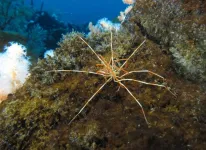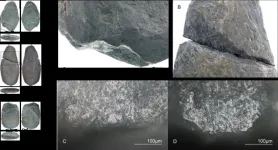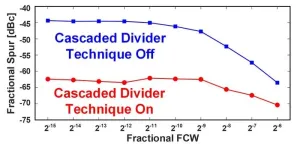(Press-News.org) Communities must be better prepared for flooding in their homes and businesses, an expert warns, as climate change predictions suggest more extreme flooding globally.
Floods still inflict major costs to the economies, livelihoods and wellbeing of communities, with flood risks and impacts set to increase further due to climate change (IPCC, 2021).
Professor of Environmental Management, Lindsey McEwen explains how many experts now believe local communities have critical roles as key actors within flood risk management and disaster risk reduction.
Professor McEwen, author of Flood Risk and Community Resilience, said: “Flood risks are becoming more diverse, as are the communities they affect. So the question is, how can communities become more resilient?”
Increased risk
Professor McEwen offers various studies to show more extreme flooding is likely in developed world settings, with an increasing impact on people.
As well as the growing impact of climate change, there is also an increase in the economic value of assets on floodplains. One study predicts these annual flood damages in Europe could rise from EUR 5.3 billion to 40 billion by 2050, with numbers of people affected increasing from 200 thousand to over 0.5 million.
Professor McEwen collates evidence from up-to-date research, policy, and practice literature on community-focused flood risk management and draws on over 20 years of research and experience of working with diverse at-risk communities to outline the misconceptions and barriers to risk management, and the opportunities for progress.
She says the first misconception about flood mitigation is that it can be solved purely through state-funded engineering solutions.
“Investing in large infrastructure projects as the sole flood management solution simply hasn’t reduced ecological, financial and even sentimental losses,” she explains. “Investment in defensive infrastructure alone, with its costs and design limits, can only be part of the solution.”
Mitigating risk
Residual risk is risk remaining after any flood risk management measures have been implemented, for example, by government agencies. Professor McEwen argues that effective risk management involves all stakeholders, with an ‘urgent imperative’ for the public to take some responsibility for residual flood risk and their own protection.
“Flood risk management is all about how we shift the focus away from reactive responses to preparation and resilience at the household and community level. Much of that residual risk management needs to happen at a local level, but people might not have the necessary information, skills or resources to do this,” she explains.
Local flood risk management involves more than just government bodies, including non-government organisations (NGOs), community flood groups, small businesses, and local cultural and media actors.
“Critical is where responsibilities for mitigation of residual risk sit within the public psyche. Flood risk management, needs networks, collaboration and communication, including increasingly participation of local communities as key stakeholders. In some settings, structural measures, often implemented by government, offset design risk but residual risk remains,” she explains.
Professor McEwen argues even with non-structural flood risk management techniques, such as land-zoning, led by government or other actors, these often still require community awareness and agency to be effective, e.g. engaging with early flood warning systems.
“Even with these measures, residual flood risk remains to be dealt with by households at risk, such as through property-level protection.”
Barriers to success
One of the issues with community resilience, Professor McEwen posits, is that some people can view this as a ‘government retreat in responsibility’, rather than working alongside statutory interventions.
“A key question is how to increase community participation and agency when there is expectation of a key role of the state still pervades. There is a wider perceived disconnect between citizens and water in the developed world,” she explains.
“While effective community-focused flood risk management requires action from communities and a wider group of stakeholders, communities have variable knowledge, empowerment or resources to participate in local flood risk planning.”
It can also involve citizen involvement in wide-ranging community activities (e.g., local governance, volunteering, mutual aid and activism) working with and through community-based organisations, businesses, and non-government organisations (NGOs) involved in community development and resilience building.
Another barrier to sustainable risk management is people’s individual vulnerability, including age, health, income, isolation and housing characteristics.
Hurricanes hitting the east coast of the U.S. are frequently cited as examples of differential impacts among particular racial, ethnic, and socio-economic groups. In just two examples, Hurricane Katrina in 2005 and Hurricane Harvey in 2017, African Americans, non-Hispanic Black and socio-economically deprived residents were hardest hit. These groups had constrained access to resources necessary for response, recovery, and medical care.
“To reduce personal losses, citizens – individually and collectively – need to be aware of what can or will be done by the state, what residual risk remains, and make plans to mitigate against that remaining risk” Professor McEwen concludes.
END
Communities must get prepared for increased flooding due to climate change, expert warns
2024-02-19
ELSE PRESS RELEASES FROM THIS DATE:
Giant Antarctic sea spiders reproductive mystery solved by UH researchers
2024-02-18
Link to video and sound (details below): https://spaces.hightail.com/receive/JwM0o5gQdq
The reproduction of giant sea spiders in Antarctica has been largely unknown to researchers for more than 140 years, until now. University of Hawaiʻi at Mānoa scientists traveled to the remote continent and saw first-hand the behaviors of these mysterious creatures, and their findings could have wider implications for marine life and ocean ecosystems in Antarctica and around the world.
Sea spiders, or ...
This tiny, tamper-proof ID tag can authenticate almost anything
2024-02-18
A few years ago, MIT researchers invented a cryptographic ID tag that is several times smaller and significantly cheaper than the traditional radio frequency tags (RFIDs) that are often affixed to products to verify their authenticity.
This tiny tag, which offers improved security over RFIDs, utilizes terahertz waves, which are smaller and travel much faster than radio waves. But this terahertz tag shared a major security vulnerability with traditional RFIDs: A counterfeiter could peel the tag off a genuine item and reattach it to a fake, and the authentication system would be none the wiser.
The researchers have now surmounted ...
Viruses that can help ‘dial up’ carbon capture in the sea
2024-02-17
DENVER – Armed with a catalog of hundreds of thousands of DNA and RNA virus species in the world’s oceans, scientists are now zeroing in on the viruses most likely to combat climate change by helping trap carbon dioxide in seawater or, using similar techniques, different viruses that may prevent methane’s escape from thawing Arctic soil.
By combining genomic sequencing data with artificial intelligence analysis, researchers have identified ocean-based viruses and assessed their genomes to find that they “steal” genes from other microbes or cells that process carbon in the sea. Mapping microbial ...
Imageomics poised to enable new understanding of life
2024-02-17
Embargoed until 1:30 p.m. ET, Saturday Feb. 17, 2024
DENVER – Imageomics, a new field of science, has made stunning progress in the past year and is on the verge of major discoveries about life on Earth, according to one of the founders of the discipline.
Tanya Berger-Wolf, faculty director of the Translational Data Analytics Institute at The Ohio State University, outlined the state of imageomics in a presentation on Feb. 17, 2024, at the annual meeting of the American Association for the Advancement of Science.
“Imageomics ...
Scientists try out stone age tools to understand how they were used
2024-02-17
Tokyo, Japan – Researchers from Tokyo Metropolitan University crafted replica stone age tools and used them for a range of tasks to see how different activities create traces on the edge. They found that a combination of macroscopic and microscopic traces can tell us how stone edges were used. Their criteria help separate tools used for wood-felling from other activities. Dated stone edges may be used to identify when timber use began for early humans.
For prehistoric humans, improvements in woodworking technology were revolutionary. While Paleolithic (early stone age) artifacts point to the use of wood for simple tools such as spears ...
Combating fractional spurs in phase locked loops to improve wireless system performance in Beyond 5G
2024-02-17
Two innovative design techniques lead to substantial improvements in performance in fractional-N phase locked loops (PLLs), report scientists from Tokyo Tech. The proposed methods are aimed to minimize unwanted signals known as fractional spurs, which typically plague PLLs used in many modern radar systems and wireless transceivers. These efforts could open doors to technological improvements in wireless communication, autonomous vehicles, surveillance, and tracking systems in beyond 5G era.
Many emerging and evolving technologies, such as self-driving vehicles, target tracking systems, and remote sensors, rely on the high-speed and error-free operation ...
20th Annual National Jewish Health Respiratory Disease Young Investigators’ Forum calls for abstracts
2024-02-17
DENVER — Young physician investigators interested in research careers in pulmonology, allergy and immunology, pediatric and related programs, are encouraged to submit basic science or clinical research abstracts by June 3, 2024, to be considered for participation in the 20th Annual Respiratory Disease Young Investigators’ Forum. This year’s Forum will take place October 17-20, 2024, in Denver.
The annual event provides career development and research opportunities for fellows and early career faculty. The Forum is a celebration of talent and ingenuity in respiratory medicine. Physician-scientists in fellowship ...
Study highlights importance of genetic sequencing to diagnosis of growth disorders
2024-02-16
In an article published in the Journal of Pediatrics, researchers based in Brazil describe the case of a nine-year-old boy admitted to hospital with multiple symptoms and overlapping conditions that made diagnosis difficult, such as short stature, thin tooth enamel (dental enamel hypoplasia), moderate mental deficiency, speech delay, asthma, mildly altered blood sugar, and a history of recurring infections in infancy.
The team used exome sequencing, in which only the protein-coding portion of the genome is analyzed, to look for genetic mutations, and found them in GCK and BCL11B. ...
Sylvester appoints prominent oncologist-researcher to lead transplantation and cellular therapy
2024-02-16
MIAMI, FLORIDA (Feb. 15, 2024) – Prominent oncologist and researcher Damian Green, M.D., will join Sylvester Comprehensive Cancer Center at the University Miami Miller School of Medicine this spring to lead its transplantation and cellular therapy services.
Green will serve as chief of Sylvester’s Division of Transplantation & Cellular Therapy, as well as assistant director of Translational Research, beginning March 1. He joins Sylvester from Fred Hutchinson Cancer Center in Seattle, where he built a distinguished track record in research and ...
Without social distancing, how do bacteria survive a viral epidemic?
2024-02-16
By Wynne Parry
WOODS HOLE, Mass. – Like humans struggling to get through the COVID-19 pandemic, bacterial cells need social distancing to thwart viruses. But in some situations, such as inside elevators or within the candy-colored bacterial structures known as “pink berries,” staying apart just isn’t feasible.
Looking like spilled Nerds or Pop Rocks, the communal, multicellular pink berries litter the submerged surface of salt marshes in and around Woods Hole. New research conducted at the Marine Biological ...





